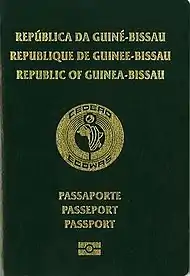Guinea-Bissau passport
Republic of Guinea-Bissau passports are issued to citizens of Guinea-Bissau to travel outside the country. Guinea-Bissau citizens can travel to member states of the Economic Community of West African States (ECOWAS) without a passport.

| Guinea-Bissau passport | |
|---|---|
 The front cover of a contemporary Guinea-Bissau passport | |
| Type | Passport |
| Issued by | |
| Purpose | Identification |
| Eligibility | Guinea-Bissau citizenship |
Types
Guinea-Bissau passports come in three forms:
Ordinary passport
- Issued to all citizens of the Republic of Guinea-Bissau for international travel.
Official passport
- Issued to all individual citizens who work for the government and have to travel on official business.
Diplomatic passport
- Issued to diplomats and their family members when they serve overseas.
Passport cover
Guinea-Bissau passports are dark green in color, with the words "Republic of Guinea-Bissau" inscribed on top of the booklet. The Guinea-Bissau coat of arms is emblazoned in the center of the cover page, followed on the bottom by the inscription of the word "PASSAPORTE" on ordinary passports.[1]
Passport information
The given below information is printed on the identification page in Portuguese and English.
- Type
- Passport No.
- Given name(s)
- Date of birth
- Sex
- Place of birth
- Place of Issue
- Date of expiry
- Surname
- Nationality
- Residence
- Date of issue
See also
References
- http://commons.wikimedia.org/wiki/File:Passaporte_Guin%C3%A9-Bissau.jpg Description of Cover
| |||||||||||||
| |||||||||||||
| |||||||||||||
| |||||||||||||
| By continent |
| ||||||||||||||||||||
|---|---|---|---|---|---|---|---|---|---|---|---|---|---|---|---|---|---|---|---|---|---|
| By type | |||||||||||||||||||||
| Other | |||||||||||||||||||||
| Defunct | |||||||||||||||||||||
| Types |
|
|---|---|
| Hospitality industry | |
| Terminology |
|
| Travel literature | |
| Trade associations |
|
| Trade fairs and events | |
| Lists | |
| |
Visa policy by country | |||||||||||
|---|---|---|---|---|---|---|---|---|---|---|---|
| Africa |
| ||||||||||
| Americas |
| ||||||||||
| Asia |
| ||||||||||
| Europe |
| ||||||||||
| Oceania | |||||||||||
1 British Overseas Territories. 2 Open border with Schengen Area. 3 Russia is included as a European country here because the majority of its population (80%) lives in European Russia. 4 These countries span the conventional boundary between Europe and Asia. 5 Part of the Realm of New Zealand. 6 Partially recognized. 7 Unincorporated territory of the United States. 8 Part of Norway, not part of the Schengen Area, special open-border status under Svalbard Treaty. 9 Part of the Kingdom of Denmark, not part of the Schengen Area. 10 Egypt spans the boundary between North Africa and the Middle East. | |||||||||||
Visa requirements | |||||||||||
|---|---|---|---|---|---|---|---|---|---|---|---|
| Africa |
| ||||||||||
| Americas |
| ||||||||||
| Asia |
| ||||||||||
| Europe |
| ||||||||||
| Oceania | |||||||||||
| Other | |||||||||||
1 British Overseas Territories. 2 Part of the Schengen Area. 3 Open border with Schengen Area. 4 Azerbaijan, Georgia, Turkey, Kazakhstan and the partially recognised republics of Abkhazia and South Ossetia each span the conventional boundary between Europe and Asia. 5 Cyprus, Armenia, and the partially recognised republics of Artsakh and Northern Cyprus are entirely in Southwest Asia but have socio-political connections with Europe. 6 Egypt spans the boundary between North Africa and the Middle East. 7 Partially recognized. 8 Part of the Kingdom of Denmark, not part of the Schengen Area. 9 Russia has territory in both Eastern Europe and Northern Asia. The vast majority of its population (80%) lives in European Russia. 10 Part of the Nordic Passport Union. | |||||||||||